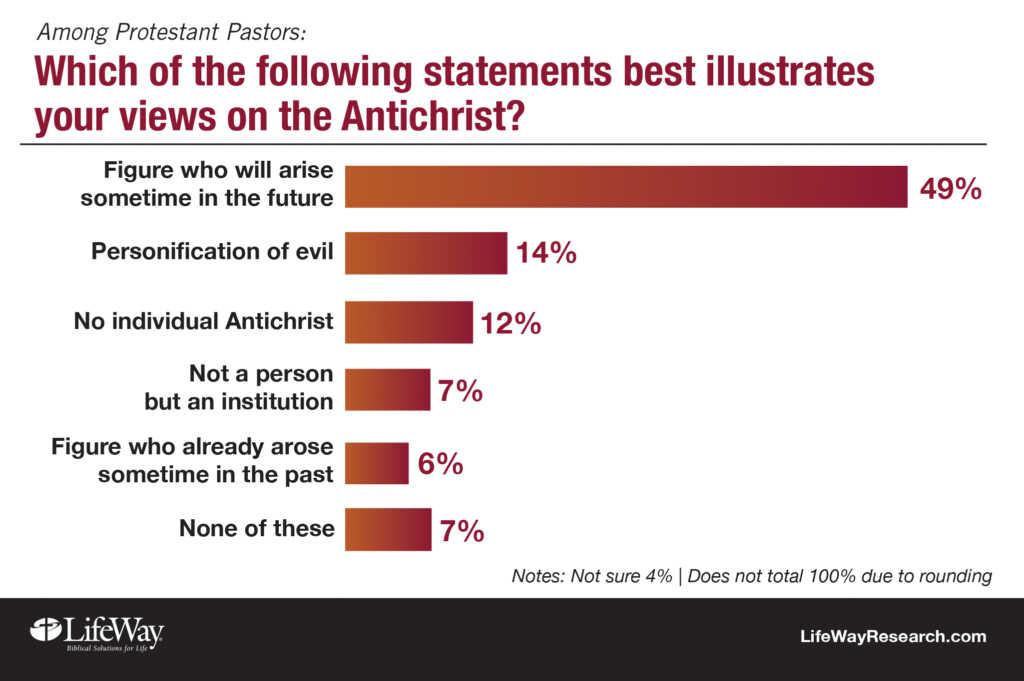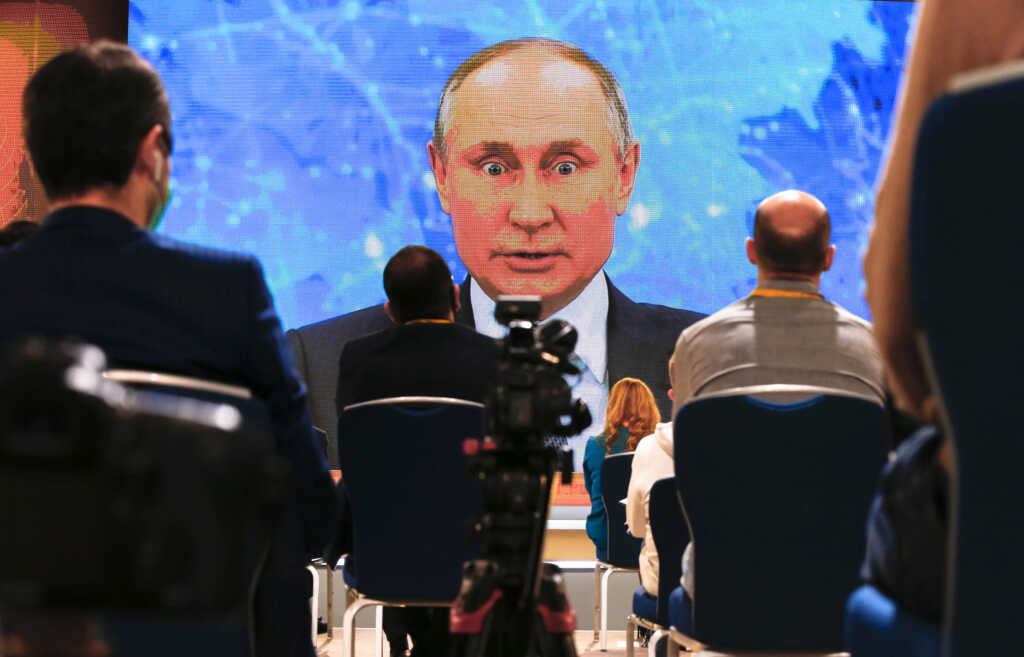A recent proclamation from a Ukrainian Orthodox Church official that Russian President Vladimir Putin is the “anti-Christ of our current time” has added yet another layer of intrigue to the mounting eschatological questions surrounding Putin’s Ukraine invasion.
Listen to the latest episode of the Faithwire podcast 👇
Who is the antichrist? What does it mean to be like the antichrist? Is Putin possibly the fulfillment of this sinister, biblical figure?
These are just some of the questions emerging after Yevstratiy Zoria, spokesman for the Ukrainian Orthodox Church, told BBC reporter Harry Farley he believes Putin is the “anti-Christ because … what he do now, is totally against Gospel, against God’s law.”
Author and end-times expert Jeff Kinley recently appeared on Faithwire to discuss these important themes and questions. We previously spoke with Kinley about the “Gog and Magog” prophecies in Ezekiel. In a follow-up discussion, we dove into Bible verses he believes predict the rise of a future antichrist figure.
Kinley, a premillennialist and author of “Interview With the Antichrist,” explained that the word “antichrist” occurs about five times in Scripture. And while there are many perspectives on the rapture, tribulation, and everything in between, Kinley broke down his take on the antichrist’s placement in the end-times paradigm.
“He’s depicted as an end-times figure who will arrive in the last days and who will be in prominence during the last seven years of earth’s history,” he said. “He’ll basically be a global leader. He’ll be the global leader of the planet.”
Watch Kinley explain the ins and outs of the antichrist:
Is Putin the antichrist?
Kinley said he finds speculation about whether Putin is the antichrist to be quite intriguing, especially considering what he argues the Bible contends.
According to Kinley, the antichrist arrives “through a peace platform” and not through war or invasion.
This, thus, makes Putin — a man actively using violence — an incompatible contender, at least at the moment. This is especially true as most of the world decries Russia’s actions in Ukraine.
“Revelation 6:1 makes that clear that he comes with a bow but no arrows,” Kinley said. “And Daniel 9:27 says he really kind of launches his career based on a peace covenant that he makes with the Jewish people.”
What is the spirit of the antichrist?
Circling back to Zoria’s words, it’s important to note that the spokesman said Putin is the “antichrist of our current time,” not the one definitive antichrist figure in which many Christians believe.
A number of Scriptures discuss the concept of the “spirit of the antichrist” and GotQuestions simply defines the term as, “against Christ.”
Among the Scriptures that do discuss this term is 1 John 2:18, which reads (NIV): “Children, it is the last hour, and as you have heard that antichrist is coming, so now many antichrists have come. Therefore we know that it is the last hour.”
The idea here is that “many” have had the spirit — the anti-Jesus stature — of the antichrist.
“The spirit of antichrist is alive and well today [and] there have been many antichrist-like figures throughout history,” Kinley explained. “Going as far back as Antiochus Epiphanes (167 B.C.), who invaded the Jewish temple, slaughtered a pig, erected an altar to himself and a statute to himself.”
Antiochus Epiphanes, a Greek king, persecuted and murdered many Jews and his treatment of the temple was seen as horrific. Kinley said plenty of other figures have similarly been viewed as antichrist-like. This includes Roman Emporer Nero and German leader Adolf Hitler, the man responsible for the Holocaust.
Still, Kinley believes the final antichrist will be a different — a “distinctive” figure who wields global control. As for the antichrist’s specific identity, Kinley said no one will know before his rise.
“I don’t think we can really know who the antichrist is definitively right now,” he said. “And if you do know who he is, then bad news: You’re in the tribulation period.”
Beast out of the sea vs. beast out of the Earth
Kinley pointed to Revelation 13 and the references of the “beast out of the sea” and the “beast out of the Earth,” explaining his belief that the former is the antichrist.
“There are actually two beasts we read about in Revelation 13 and it’s the same word used to describe both of them … which means ‘a wild, ravenous beast,'” Kinley explained. “And it says that the second beast that later is identified as the false prophet.”
The false prophet, Kinley believes, will go after Christians and others and will enact 666, the well-known Mark of the Beast. This figure will presumably point people back to the antichrist.
Listen to the latest episode of the Faithwire podcast 👇
“He is the spokesperson of the Antichrist,” he said. “He’s his henchman … he basically promotes him.”
The Bible does, indeed, speak of these images in fascinating detail. Revelation offers some complex descriptions and says the beast of the sea will wield authority. Verses 1-5 are particularly intriguing:
“It had ten horns and seven heads, with ten crowns on its horns, and on each head a blasphemous name. The beast I saw resembled a leopard, but had feet like those of a bear and a mouth like that of a lion. The dragon gave the beast his power and his throne and great authority. One of the heads of the beast seemed to have had a fatal wound, but the fatal wound had been healed. The whole world was filled with wonder and followed the beast. People worshiped the dragon because he had given authority to the beast, and they also worshiped the beast and asked, ‘Who is like the beast? Who can wage war against it?'”
The chapter goes on to say the beast would slander God and the world will worship him. Then there’s the beast out of the earth, who takes on a very different form.
The beast out of the earth also has an interesting description, having “two horns like a lamb” but speaking like a dragon. The Scriptures note this beast points people back to the beast of the sea in worship. Read more here.
Not everyone agrees
Kinley acknowledged not everyone agrees with his take on the antichrist, as a plethora of divergent theological ideas have emerged to help explain the complexities in the literature. The author said he understands the pushback, but believes in the power of taking a literal approach to these Scriptures.
“I and many other scholars approach the Scripture from a literal, grammatical, historical textual approach,” Kinley said. “And when you approach it that way and just simply let the Bible speak for itself and you know there are symbols in Revelation, there are metaphors, there are things that [the Apostle] John uses.”
However, Kinley believes the verses are explained in the text, especially if read through the proper lens. With all that in mind and with biblical and contextual understanding, he believes his views on the antichrist are intensely biblical.

It should be noted that research conducted in 2016 for “The Armageddon Code: One Journalist’s Quest for End-Times Answers” revealed divergent views among Christian pastors when it comes to the antichrist. The plurality of Protestant pastors agreed with Kinley, though sizable portions took different positions.
While 49% of preachers said they believe the antichrist will rise sometime in the future, 14% said the antichrist is simply a personification of evil, 12% said there is no individual antichrist, 7% said it is not a person but an institution and 6% said it was a figure who already arose in the past.
“When you read revelation just at face value you come to the conclusion that, yes there will be a real antichrist. He will be a real person. He will be a man he will rise in the last days and he will rule the existing world,” he said.
Explore Kinley’s book, “Interview With the Antichrist,” and watch the video discussion for more.
***As the number of voices facing big-tech censorship continues to grow, please sign up for Faithwire’s daily newsletter and download the CBN News app, developed by our parent company, to stay up-to-date with the latest news from a distinctly Christian perspective.***



